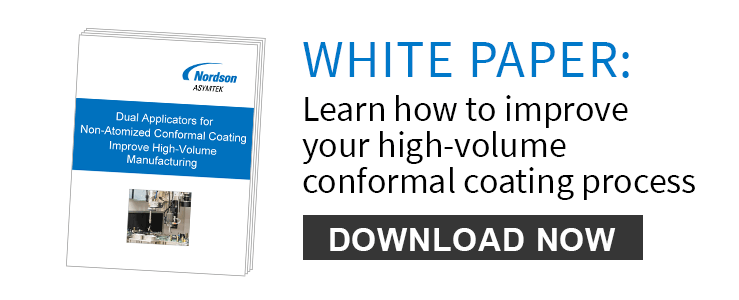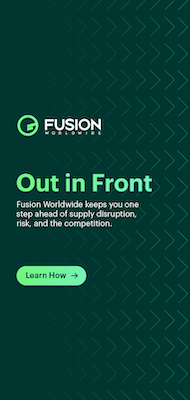Sponsored content by Nordson ASYMTEK

Dual applicators and non-atomized conformal coatings are proven best for high-volume manufacturing
For solvent-based, high-volume electronics applications, non-atomized coating gives:
• Finer edge definition for tighter keep-out zones
• Faster coating-line speeds
• Single-pass coverage for greater UPH
Adding a dual, non-atomized applicator, jet, or needle, further optimizes the process and dispensing set-up. The system selectively coats smaller areas that might be impossible to coat without using a mask. Automated selective-coating systems provide an in-line, hands-off process, reduce (or eliminate) product handling, protect the coated products, optimize UPH and repeatability, and reduce material costs. Nordson ASYMTEK research shows that non-atomized conformal coating results in more control, precision, and throughput over traditional atomized spraying.
Dual Applicators for Non-Atomized Conformal Coating Improve High-Volume Manufacturing
By Camille Sybert and Michael Szuch, Nordson ASYMTEK
The goal in high-volume manufacturing is to optimize the dispensing set-up so it improves dispense quality, process control, reliability, and repeatability, while reducing material costs. To achieve high-quality, accurate, repeatable coating with efficient throughput, non-atomized coating, instead of atomized coating, is used. Adding a dual, non-atomized applicator, jet, or needle, further optimizes the process and dispensing set-up.
Atomized spray is the most common method for applying conformal coating. It disperses the material into a fine mist. Non-atomized coating, or selective coating, controls the coating material’s dispense shape while maintaining the original liquid form. Selective coating coats specific components or areas of a board while respecting keep-out zones (KOZs). It increases transfer efficiency, selectivity, throughput, and yield, and reduces masking and rework.
Selective coating can be applied to a broad area with a film coating applicator for dispensing passes up to 750mm/second with clean edge definition or can apply discrete dots using a jet valve. When both are used on the same platform, manufacturers can create coating programs that maximize control, reduce waste, increase throughput, selectively coat, and reduce rework. Adding process controls to an automated system provides accountability with traceability and process parameter maintenance.
Non-Atomized Coating Methods
Non-atomized dispensing methods include film coating, needle dispensing, and jetting. All work well with solvent-based materials, which are used to improve transfer efficiency, selectivity, and throughput.
Non-atomized coating methods mold the fluid shape to obtain selectivity, clean edge definition, and ensure desired dispense volumes. They provide a higher wet-dispense accuracy without overspray. Each method provides a different degree of selectivity, so complex boards often benefit from using a combination of these applicators.
Film Coater
Film coaters dispense in two shapes: a leaf pattern made with a cross-cut nozzle to establish a fan-shape pattern that dispenses a curtain of material as the applicator moves, and at the perpendicular angle, a knife edge that sets the pass edge on the substrate. The shape enables the placement of significant quantities of fluid in broad, wide passes that are ideal for low-profile, surface mount populated boards. While selective, the film coater dispenses large volumes of material.
Needle Dispensing
Needle applicators have a wider viscosity range than film coaters and can be used for complementary applications. They use fluid reservoir pressure to push the material through the needle to form a narrow bead, working on time/pressure technology. The needle’s uniform, narrower pattern shape enables contouring patterns, like circles or sharp 90-degree angles. Using a continuous path program routine can seamlessly smooth contour lines into a clean perimeter dispense. The time-pressure needle applicator is practical with a broad range of materials, but lacks precise volume control.
Jet Dispensing
A jet applicator can dispense discrete dots because it has the finest volume control and positional accuracy. Dots are spaced far enough apart to reduce the material volume applied, yet close enough to flow and provide conformal coating coverage. Lines are comprised of a series of dots that blend together. Parallel lines can create area coats. By controlling the volume of each dot, the system controls the volume of material dispensed across lines and coating patterns. A jet dispenser can dispense into tight locations or close to a component in very thin lines without exceeding the KOZs.
Pairing Applicators for Dual Applicator Operation
Needle and jet applicators, paired with non-atomized film coaters, optimize the benefits in high-volume electronics manufacturing. Conformal coating programs can take advantage of the film coater’s speed and broad passes while the paired applicator provides finesse, accessibility, and better access around vertical components. The flexibility of the applicator allows for finely-tuned conformal coating dispenses. Dispense needles come in different gages, lengths, and shapes to best aid the application. Tip options allow jet and needle applicators to have accessibility around tall components and can provide narrower dispense widths.
When the process is run by primarily using the film coater and pairing it with the jet’s detail work, cycle-time may be improved over a spray applicator. A dual applicator set-up allows the operator to dispense the border around key KOZs and proceed to the larger volume dispense applicator within the same program. The conformal coating system can toggle the appropriate applicator that the program calls for. Tilt and rotate options further flexibility.
Closed-Loop Process Controls for Conformal Coating
Automated conformal coating systems often have software that manages automatic maintenance routines and provides closed-loop process controls to improve performance and help ensure quality during high-volume production. Software controls the dispense volume by modifying pulse-width modulation. Timing controls adjust the amount of material passing through the valve. Jetting actuation accelerates the fluid to break off. Dot spacing can be controlled by timing or spacing distance. Appropriate spacing reduces splashing by not placing wet dots on top of each other.
When dispensing with a film coater, maintaining the material’s shape and width is critical for uniform dispensing. Laser fan width control helps maintain a consistent fan width throughout production. Numerous other software features can be employed to control and improve every aspect of the conformal coating process.
Summary
Conformal coating is used in high-volume electronics manufacturing for the automotive, computer, communications, and consumer product manufacturing markets. A large portion of those applications require solvent-based coatings, which lend themselves to non-atomized application.
The non-atomized approach, as compared to atomized spraying, provides superior edge definition, higher coating speeds, more precise and accurate application, and single-pass coverage. The finer edge definition accommodates tighter keep-out zones while reducing or eliminating the need for masking. The film coater’s faster line speeds and single-pass coverage translate to higher UPH. With the addition of a dual non-atomized applicator, the system can also selectively coat smaller areas that might otherwise be impossible to coat without using a mask. For high-volume manufacturers, automated selective coating systems provide an in-line, fully hands-off process that reduces or eliminates product handling by the operators, protects the coated products, and optimizes UPH and repeatability.
Download the full article: http://ndsn.tech/07evdawpna






